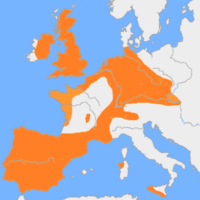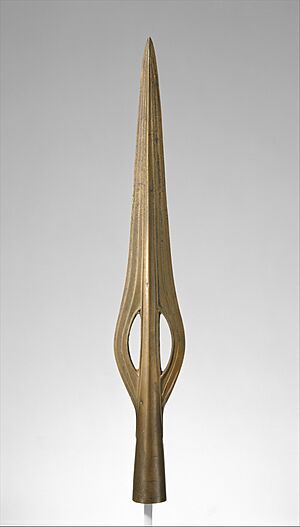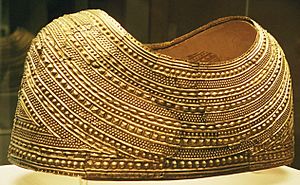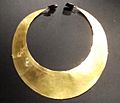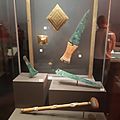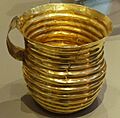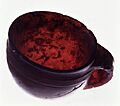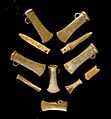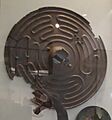Bronze Age Britain facts for kids
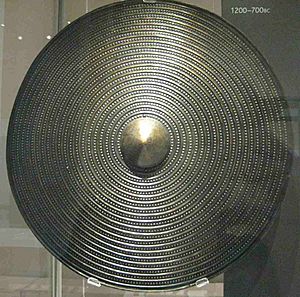 |
|
| Geographical range | British Isles |
|---|---|
| Period | Bronze Age |
| Dates | c. 2200 — c. 800 BC |
| Preceded by | Bell Beaker culture, Neolithic British Isles |
| Followed by | Atlantic Bronze Age, Iron Age Britain |
The Bronze Age in Britain was a long period in British history. It lasted from around 2500 BC to 800 BC, about 1,700 years. Before this time, people lived in Neolithic Britain (the New Stone Age). After it came the Iron Age Britain.
During the Bronze Age, people in Britain started using new metals. First, they used copper, and then they learned to make bronze. Bronze is a mix of copper and tin. They used these metals to make tools and weapons. This period also saw a big increase in agriculture, meaning more farming.
People continued to build or change large stone monuments, called megaliths. Famous sites like Avebury, Stonehenge, Silbury Hill, and Must Farm were important. This was a time when special ceremonies became common among farming communities.
Contents
History of Bronze Age Britain
The Bronze Age in Britain is divided into three main parts. It's sometimes hard to say exactly when each part started or ended.
Early Bronze Age: 2500–1500 BC
Some experts say the Bronze Age began around 2200 BC. Others say it was closer to 2000 BC. The time from 2500 BC to 2000 BC is sometimes called the "Late Neolithic/Early Bronze Age." This is because it's hard to tell the exact changeover.
Some archaeologists talk about a "British Chalcolithic" period. This was when copper was used, between 2500 BC and 2200 BC. But not everyone agrees, as copper was used only a little.
- 2500–2000 BC: The Bell Beaker culture started. People used copper and tin.
- 2100–1900 BC: More advanced tools like knives and spearheads appeared.
- 1800–1600 BC: Burials became more common.
Middle Bronze Age: 1500–1000 BC
- 1500–1300 BC: New types of axes and spearheads were made. People used copper, tin, and some lead.
- 1300–1200 BC: Long, thin swords called "rapiers" were used.
- 1200–1000 BC: People started burying their dead in urns.
Late Bronze Age: 1000–700 BC
- 1000–900 BC: More advanced axes were made, sometimes with lead.
- 800–700 BC: Leaf-shaped swords became popular.
In Ireland, the Bronze Age ended around 600 BC. But people didn't start using iron until about 550 BC.
How Britain Changed in the Bronze Age
The Beaker People and Culture


Around 2500 BC, a new style of pottery arrived in Britain. This was from the Beaker culture. Along with this pottery, people started using flat axes. They also began burying individuals instead of groups.
People from mainland Europe came to the islands. Studies of teeth from graves near Stonehenge show that some newcomers came from what is now Switzerland. The Beaker culture brought many new ways of doing things. They even used some of the old henge sites.
Burial customs changed a lot. In the Stone Age, people buried many dead in large chambered cairns or long barrows. In the Bronze Age, people were often buried alone. They were placed in barrows (burial mounds) or in stone boxes called cists. Often, a special beaker pot was buried with the body. Even with these changes, burial mounds were still important. Smaller tombs were sometimes dug into older mounds.
For a long time, experts debated if the "Beaker people" were new people who moved to Britain. Or if their ideas and goods just spread through trade. However, a recent study from 2017 found something important. It showed that a large part of Britain's original Stone Age population was replaced. This happened when people similar to the Beaker people from the Lower Rhine region (modern Netherlands/Germany) arrived. These newcomers had a lot of "steppe ancestry." This means their ancestors came from the grasslands of Eastern Europe.
A scientist named Ian Barnes said that after the Beaker people arrived, the population in Britain had genes for skin and eye color similar to people in Britain today.
The Rise of Bronze
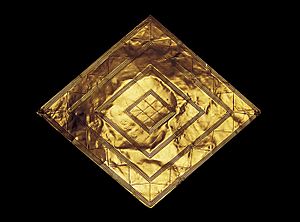
The Beaker culture brought the skill of working with metal to Britain. At first, people made things from copper. But around 2150 BC, metalworkers learned a new trick. They found out how to mix copper with a little bit of tin to make bronze. Bronze is much stronger than copper. This discovery started the Bronze Age in Britain. Over the next 1,000 years, bronze slowly took the place of stone for making tools and weapons.
Bronze axe heads were made by casting (pouring melted metal into a mold). At first, they looked like stone axes. But then they got a special hole for the wooden handle. They also had a small loop to help tie the handle on. Many unused axes are found together. Some think these were offerings in rituals. Others believe rich groups collected bronze items and controlled who could use them. Many graceful, leaf-shaped bronze swords have been found. So have spearheads and arrow points.
Britain had a lot of tin, especially in Cornwall and Devon. So, tin mining began. By about 1600 BC, the South-West of Britain was very busy with trade. British tin was sent all over Europe.
Bronze Age Britons were also very good at making jewelry from gold. They made special items like the Rillaton Cup and the Mold Cape. Many gold objects have been found in the graves of wealthy people from the Wessex culture in Southern Britain.
The most bronze objects in England were found in East Cambridgeshire. Over 6,500 pieces were found in Isleham.
The oldest known metalworking workshop was found in Sigwells, Somerset. Pieces of molds for making swords were found there. These pieces were found with grain that dates back to the 12th century BC.
Wessex and Deverel-Rimbury Cultures
The rich Wessex culture grew in southern Britain during this time. The weather became much wetter, forcing people to move from hills to fertile valleys. Large farms for animals grew in the lowlands. This helped the economy and led to more forests being cleared.
The Deverel-Rimbury culture appeared in the Middle Bronze Age (around 1400–1100 BC). They learned to farm well in the wetter conditions. Cornwall was a main source of tin for Europe. copper was dug up at places like the Great Orme mine in Northern Wales. People lived in tribes, but society became more complex. Some people became more powerful than others.
Big Changes in the Late Bronze Age

There's proof of big changes in how people lived around 1200 BC. Some experts think this might mean new people moved into Southern Britain. These changes happened far beyond Britain. Many great empires in the Near East had problems. The "Sea Peoples" attacked areas around the Mediterranean Sea.
During this time, people started burning their dead. This is called cremation. Then they put the ashes in urns. Cemeteries full of these urns have been found.
Some experts, like John T. Koch, believe that Celtic languages developed during the Late Bronze Age. This happened in a busy trading network called the Atlantic Bronze Age. This network included Britain, Ireland, France, Spain, and Portugal. However, most experts think Celtic languages developed earlier.
Late Bronze Age Migration
In 2021, a big study looked at ancient DNA. It found that people moved into southern Britain between 1300 and 800 BC. These newcomers were most like ancient people from Gaul (modern France). They had more "Early European Farmers" ancestry.
From 1000 to 875 BC, their genes spread quickly through southern Britain. They made up about half of the genes of people in the Iron Age there. But this didn't happen in northern Britain.
The study suggests this wasn't a sudden invasion. Instead, it was a slow change over centuries. Traders, marriages, and small family groups moved between Britain and mainland Europe. This could be how early Celtic languages came to Britain. There was less movement into Britain during the Iron Age. So, it's likely Celtic languages arrived before then.
The study also found that people in early Iron Age Britain became able to digest milk (lactose tolerant) very quickly. This happened 1,000 years before it was common in mainland Europe. This suggests milk became a very important food in Britain at this time.
Images for kids
-
Bush Barrow artefacts, around 1900 BC
-
Rillaton gold cup, around 1700 BC
-
Hove amber cup, around 1700 BC
-
Caergwrle Bowl, around 1300 BC.
-
The Shropshire bulla, around 1000 BC
-
Ferriby Boat model and replica tools, around 2000 BC
-
Dover Boat, around 1500 BC
-
Cadbury Castle Late Bronze Age hillfort
-
Late Bronze Age cauldron.
See also
- Prehistoric Britain
- Bronze Age Scotland
- Bronze Age Cornwall
- Bronze Age Wales
- Copper and Bronze Age Ireland
- Ferriby Boats
- List of Bronze Age hoards in Great Britain
- Bronze Age France
- Unetice culture
- Armorican Tumulus culture
- Hilversum culture
- Nordic Bronze Age
- Bronze Age Europe



